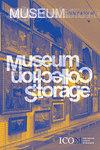Collections Space: The Final Frontier (Smithsonian Institution, US)
IF 0.4
4区 艺术学
0 ART
引用次数: 0
Abstract
Abstract To address storage challenges, the Smithsonian undertook a multi-year, highly collaborative, and Institution-wide planning initiative in 2010 to document, analyse, and plan for addressing current and projected collections space needs in a pragmatic, strategic and integrated manner. This case study provides an overview of the planning process, illustrates the innovative methodologies utilised in the initiative, and highlight outcomes which have made collections space an Institutional and budgetary priority—ensuring the long-term preservation and accessibility of Smithsonian collections. The immense scale of Smithsonian collections and collections spaces, the diversity of space types, and varied museum storage techniques constitute significant challenges for maintaining appropriate environments, security, fire safety, and storage equipment. The planning initiative established collaborative processes that engaged all stakeholders in solving collections space issues, conducted a comprehensive survey of existing Institutional conditions, and developed strategies applicable to other cultural institutions seeking efficient, sustainable collections space. The resulting Collections Space Framework Plan is a flexible roadmap to guide capital projects, provide renovation and new construction strategies that address unacceptable collections space conditions, allow for decompression of overcrowded collections, increase physical accessibility, anticipate future collections growth, and reduce reliance on lease space for collections storage. The Framework Plan has transformed the future of Smithsonian collections space. Existing conditions are documented in a database which is updated annually and analysed to prioritise improvements. It has already had a major impact on programming and securing funding for critical space improvements at Smithsonian museums and two off-site collections centres.收藏空间:最后的边疆(史密森学会,美国)
为了应对存储方面的挑战,史密森尼博物馆于2010年开展了一项为期多年、高度协作的全机构规划计划,以务实、战略性和综合的方式记录、分析和规划当前和未来的收藏空间需求。本案例研究提供了规划过程的概述,说明了该计划中使用的创新方法,并强调了使收藏空间成为机构和预算优先事项的结果——确保史密森尼收藏的长期保存和可访问性。史密森尼的藏品和收藏空间的巨大规模,空间类型的多样性,以及各种博物馆存储技术构成了维护适当环境,安全,消防安全和存储设备的重大挑战。规划倡议建立了协作流程,让所有利益相关者参与解决馆藏空间问题,对现有机构条件进行了全面调查,并制定了适用于其他文化机构寻求高效、可持续的馆藏空间的策略。由此产生的馆藏空间框架计划是一个灵活的路线图,用于指导资本项目,提供翻新和新的建设策略,以解决不可接受的馆藏空间条件,允许对过度拥挤的馆藏进行压缩,增加物理可达性,预测未来的馆藏增长,并减少对馆藏存储租赁空间的依赖。框架计划已经改变了史密森尼收藏空间的未来。现有条件记录在数据库中,该数据库每年更新并进行分析,以确定改进的优先次序。它已经对史密森尼博物馆和两个非现场收藏中心的关键空间改进的规划和获得资金产生了重大影响。
本文章由计算机程序翻译,如有差异,请以英文原文为准。
求助全文
约1分钟内获得全文
求助全文
来源期刊

MUSEUM INTERNATIONAL
ART-
CiteScore
0.60
自引率
0.00%
发文量
0
期刊介绍:
In its new revised form Museum International is a forum for intellectually rigorous discussion of the ethics and practices of museums and heritage organizations. The journal aims to foster dialogue between research in the social sciences and political decision-making in a changing cultural environment. International in scope and cross-disciplinary in approach Museum International brings social-scientific information and methodology to debates around museums and heritage, and offers recommendations on national and international cultural policies.
 求助内容:
求助内容: 应助结果提醒方式:
应助结果提醒方式:


